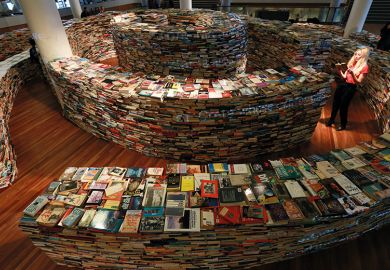This thoughtful and interesting book ranges widely over 19th-century sources and themes, focusing on Victorian attitudes to sight and the relationships between observation, perception and imagination. The illustrations, some of them little known, are an integral part of the text, and the chapter on horizons that ends the book is particularly impressive for the imaginative way that it relates pictures to words. It is more than a summary: it concludes with a poem of 1896 by Mary Coleridge that describes eyes as "Fountains of unearthly light, Prisons of the Infinite". The word prisons invites further thought. So, too, does the author's observation - set out in many ways in her book - that "visuality", explored within scientific as well as within literary texts, was "crucial to Victorian debates about the place of the individual in the world. Like the horizon, it formed a connecting line - sometimes clearly so, sometimes hazy and indistinct, between the material and the invisible worlds, between the apparently knowable and the realm of hypothesis, between the figured and the imaginative, between the body and mind."
There is no reference in this last chapter to the social horizons of 1896, a year of remarkable convergences in social history, when the instruments of future technical and social change were already in view, but the sense of how they would transform the 20th century was at best hazy and indistinct. There is ample insight in the chapter but there is far more to be said about foresight and prediction. The magic lantern figures in the book, but not the cinema, the railway (as it must), but not the automobile. There are several pages on "prevision" in an illuminating chapter called "Lifting the veil", but they concentrate on physiology, particularly "morbid anatomy", and do not note historical connotations. The dubious observation by Henry James on the subject in a communication with a heart specialist is not dated. "So long as the events are veiled," he suggested, "the imagination will run riot and depict all sorts of horrors, but as soon as the veil is lifted, all mystery disappears and with it the sense of terror." This may well have been the case in James's narration of The Turn of the Screw , but it is not the case when historians are identifying and narrating "turning points" in history. For all Kate Flint's stress on interdisciplinarity, the necessary approach to all cultural studies, there is still a gulf between the work of historians of literature and art and that of political and social historians.
The great achievement of Flint's book is to bring art and science closely together, but the interdisciplinarity is incomplete. It is curious, for example, that there is no reference in it to spectacles and the way in which they changed ways of looking at the world. The kaleidoscope, the stereoscope, the pseudoscope and the zoetrope figure as well as the magic lantern and there are stimulating reflections on microscopes and telescopes, but "glasses" are missing. So too is a long time span. It would have been interesting to have compared 19th-century implications, factual and imaginative, of new technical development with those of the 17th century.
There are a few pages on John Milton's blindness that link the centuries, with one idea common to both - that it was through his blindness that Milton was able "to see clear into the very heaven of heavens". One of the few books published in the 1930s that figures in the footnotes is Eleanor Brown's Milton's Blindness . So much has been written by historians on Milton since then that places him quite differently within a Victorian context.
One Victorian author who figures prominently both in the footnotes and in the text is John Tyndall, whose essay "On the scientific use of the imagination" is obviously a key text. It appeared in a collection of essays by him "on the use and limit of the imagination in science". How his contemporaries judged Tyndall and his work does not seem ever to have been fully considered. He made one simple observation on the eye, however, that sticks firmly in the mind when all speculations are stilled. He considered that "as a practical instrument" it "must ever remain a marvel to the reflecting mind". By contrast, the German authority Hermann von Helmholtz said that if any optician sent him an instrument "so full of defects" as a human eye he would be justified in "sending it back with the severest censure".
Glances and gazes both receive attention from Flint and the authors she quotes, some of whom do not appear in any encyclopedia. Yet it is not only glasses that are missing. The word grotesque, the subject of meticulous recent research spanning the centuries, barely figures in the book, let alone the analysis that takes in glaciers, drains and sewers and hallucinations. Advertising is barely mentioned, although there is a footnote on "commodity culture" that, however interpreted, changed significantly throughout the Victorian period, drawing not on one but on several forms of imagination. The extremely valuable chapter on the role of the art critic has its origins in Flint's doctoral thesis on "English critical reactions to contemporary painting, 1878-1910", parts of which were set out in articles that have been thoroughly re-worked as the terms of Flint's analysis changed to incorporate that which was not visible to the eye. It rightly avoids once-familiar distinctions between "background" and "foreground", but it is still necessary to use the word perspective. It is refreshing too to read a book about the Victorians that has more to say about crystal gazing than about the Crystal Palace.
Lord Briggs is president, Victorian Society.
The Victorians and the Visual Imagination
Author - Kate Flint
ISBN - 0 521 77026 2
Publisher - Cambridge University Press
Price - £45.00
Pages - 4
